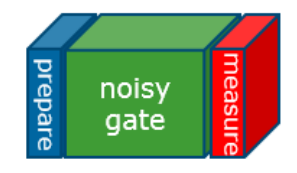qat.tomo
Quantum tomography
Warning
This is an alpha version of the module. It is therefore subject to API changes.
Tomography consists in characterizing quantum states and processes. Qaptiva comes with
a few tools to perform the quantum process tomography of Quantum Processing
Units (QPUs), i.e to determine the noise model of a given QPU (check out the
qat.quops page to learn more about noise models). These noise models
can then be used to perform noisy simulation on Qaptiva (see qat.noisy).
Basics of tomography
Determining the noise model of the gates of a quantum processor boils down to finding the parameters of the quantum channel/operation corresponding to the gate: one possible outcome is the Pauli Transfer Matrix (PTM) of the gate.
To achieve this goal, one has to remember that a quantum channel is a linear map on the vector space of density matrices, and hence can be characterized by measuring its action on a basis of density matrix. To perform this characterization, one needs to prepare at least \(4^n\) independent density matrices (with \(n\) the number of qubits), and find the projection of the final density matrix on at least \(4^n\) density matrices (in the tomography literature, the input and output density matrices or states that are used to characterize the gates are sometimes called ‘fiducial’ sequences).

Of course, the sheer number of experiments (at least \(16^n\)) is daunting and therefore limits the size of the quantum processes one can hope to characterize. A priori this is not an issue if one wants to characterize the basic building blocks of a quantum algorithm, which are usually a small set of one and two-qubit gates (this argument has to be revised, of course, if one wants to characterize crosstalk, which may involve more than two qubits; but the level of precision one wants to achieve for crosstalk may not be as stringent as for characterizing one and two-qubit gates).
This simple procedure is known as Quantum Process Tomography. It comes in two main flavors:
linear inversion QPT assumes one has an infinite precision on the measured expectation values
maximum-likelihood QPT takes into account “shot noise”, i.e. the fact that in practice we only have access to an estimate of the expectation values.
The above procedure suffers from a major flaw: it assumes one knows a priori the precise ‘fiducial’ states one can measure or project on. Yet, these states are engineered by the very gates one would like to characterize, if one does not want to make this assumption, one has to devise a more sophisticated procedure.
Gateset Tomography (see [MGS+13], [BKGN+13], [Gre15]) is an example of such a self-consistent procedure. It assumes nothing about the gates, nor about the state preparation and measurement (SPAM) operations (other than the linearity of the gates). Of course, it comes with an increased cost, and in various flavors like linear inversion and maximum-likelihood GST depending on whether shot noise is neglected or not.
Tomography on Qaptiva
Qaptiva provides implementations of two kinds of process tomography:
Quantum process tomography in linear-inversion and maximum-likelihood variants (see e.g [MGS+13])
Gateset tomography in its linear-inversion variant. This approach, gives not only the noise models of individual gates, but also a characterization of the state preparation and measurement errors (SPAM).
A high-level, single-call method to perform tomography i.e. to do data collection and post-processing is available. Functions to do each of these two steps seperately are also provided. The second usage is recommended for characterizing actual (experimental) QPUs.
Tomography functions
Collect tomography data |
|
Tomography one-liner function to collect and process the tomography data |
|
Process tomography data |
|
Prepare gatesets and fiducials |
References
Robin Blume-Kohout, John King Gamble, Erik Nielsen, Jonathan Mizrahi, Jonathan D. Sterk, and Peter Maunz. Robust, self-consistent, closed-form tomography of quantum logic gates on a trapped ion qubit. 2013. arXiv:1310.4492.
Daniel Greenbaum. Introduction to quantum gate set tomography. 2015. arXiv:1509.02921.
Seth T. Merkel, Jay M. Gambetta, John A. Smolin, Stefano Poletto, Antonio D. Córcoles, Blake R. Johnson, Colm A. Ryan, and Matthias Steffen. Self-consistent quantum process tomography. Phys. Rev. A, 87:062119, Jun 2013. URL: https://link.aps.org/doi/10.1103/PhysRevA.87.062119, doi:10.1103/PhysRevA.87.062119.